Shavings from My Bench
When I had hoards of school children come to visit me in my workshop, 7-10 year-olds, several days a week, I developed many ways to show how tools worked on wood to true and trim, smooth and shape. We counted saw strokes together and felt the wood fibres before and after planing and sawing. If I tell you I had 1,000 children come into my workplace to watch and listen to my woodworking tools in the spring and early summer it would not be an exaggeration. For ten years I did this between 10 AM and noon four days a week. They were mesmerised when I wrote their names on strips of pine and planed the surface to find the names gone. Picking the shavings up from the workbench with their names clearly marked on them and taking them home was a priceless gift I never knew would be so valued. One child came back ten year’s later with her name on a shaving and said, “I did this with you when I was ten!” She kept and used it as a bookmark.
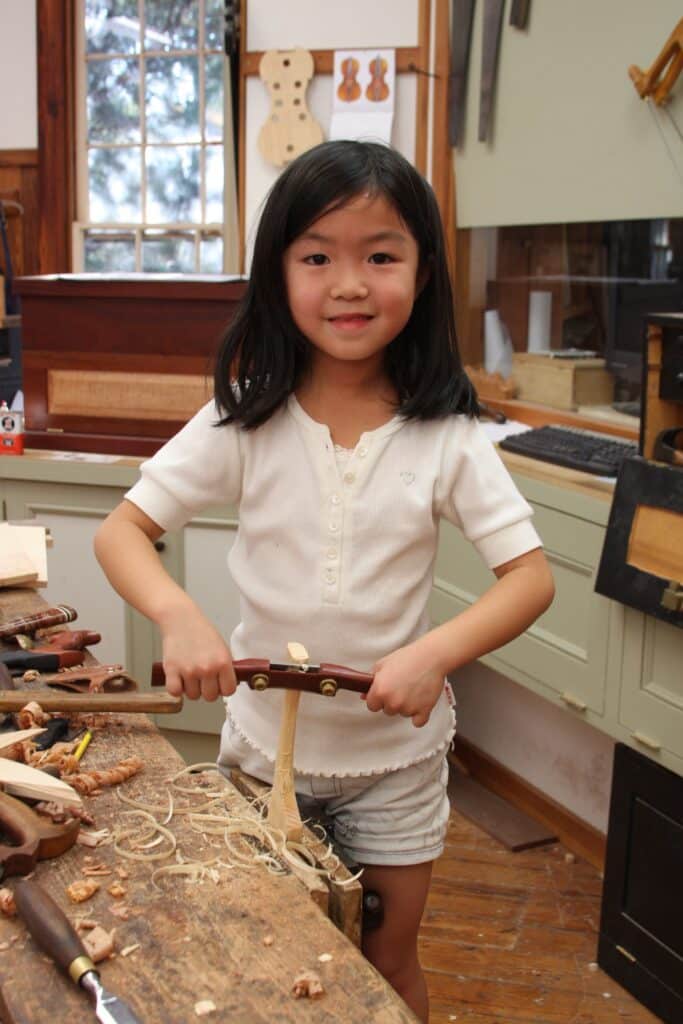
I hear more and more of teachers suddenly taking on the added tasks of teaching woodcraft to children i class. Ask most teachers about woodworking and they tell you it’s mostly about nailing wood with a hammer and nail and that we use it for construction work. Most carpenters I know would have little if any knowledge of actually planing wood and chiselling recesses to fit door locks and hinges by hand. Why would they? Clamp the router guide on the door, slide in the plunge router and hey presto the lock slides in and the door is hinged, hung and done. I am sure the US influence of stick-frame building has influenced the image of the carpenter with a claw hammer held mid air symbolises the carpenter. In my world, I would most likely never use the term carpenter as it is used in different cultures today. I would never allow my own use of the word to describe myself anymore because of its diminished meaning. No, it is not snobbism: culture has the dynamic to change meaning and the meanings of words we once could use freely and in inclusive ways might have a completely different meaning now. In the past 30 years, I have yet to see any carpenter with wide shavings from a hand plane around his ankles or actually hear a handsaw ripping through wood. Here in my workshop, I hear Hannah, Jack and John sawing all the time throughout the day, doing work that power equipment could just not do as efficiently. It’s nice. I feel success. They have and are developing skills and these three as well as others will replace me when I am indeed too old.
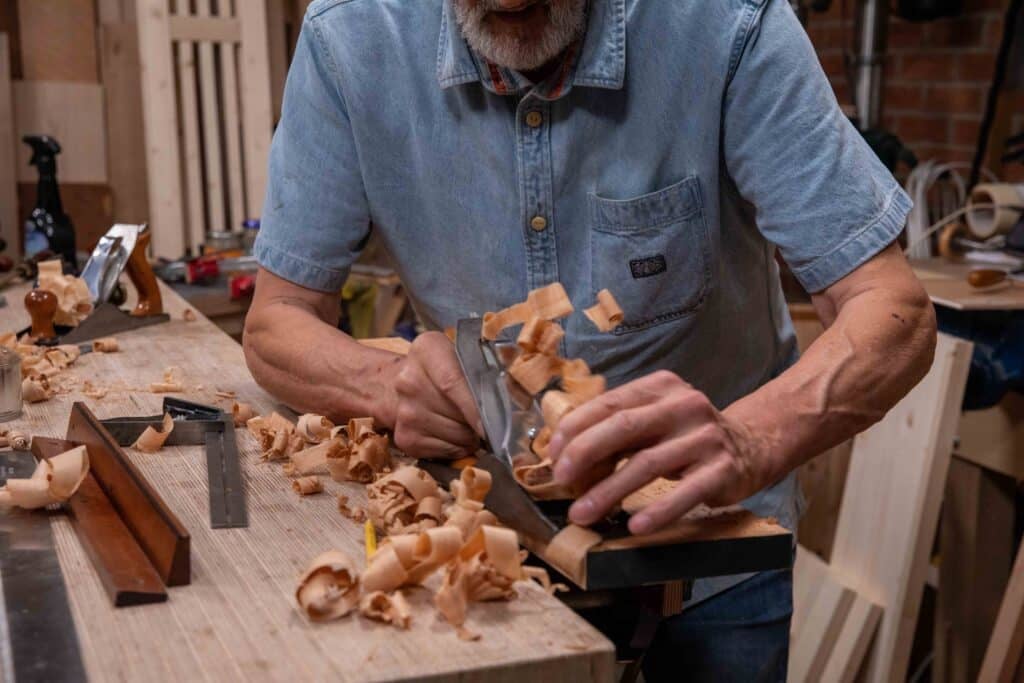
So a few days ago I started to think about wood shavings and the setting of planes. I realised that for the main part planes are set to a setting that enables us to remove material with some measure of agreement to our effort. Set a plane with too deep a cut and the plane resists and falters in the stroke to leave a step or two and more where it should feel smooth and level. I have strategies that work exceptionally well in the removing of wood quickly. To that end, my various methods equip me and save me a lot of work. Different tools provide us with options. Would `I use a drawknife in my work? Usually not. Drawknives work really well with green wood on shaving horses but not too well at the workbench and with dry and seasoned wood. Some will argue with that but no matter. That’s their world and not mine.
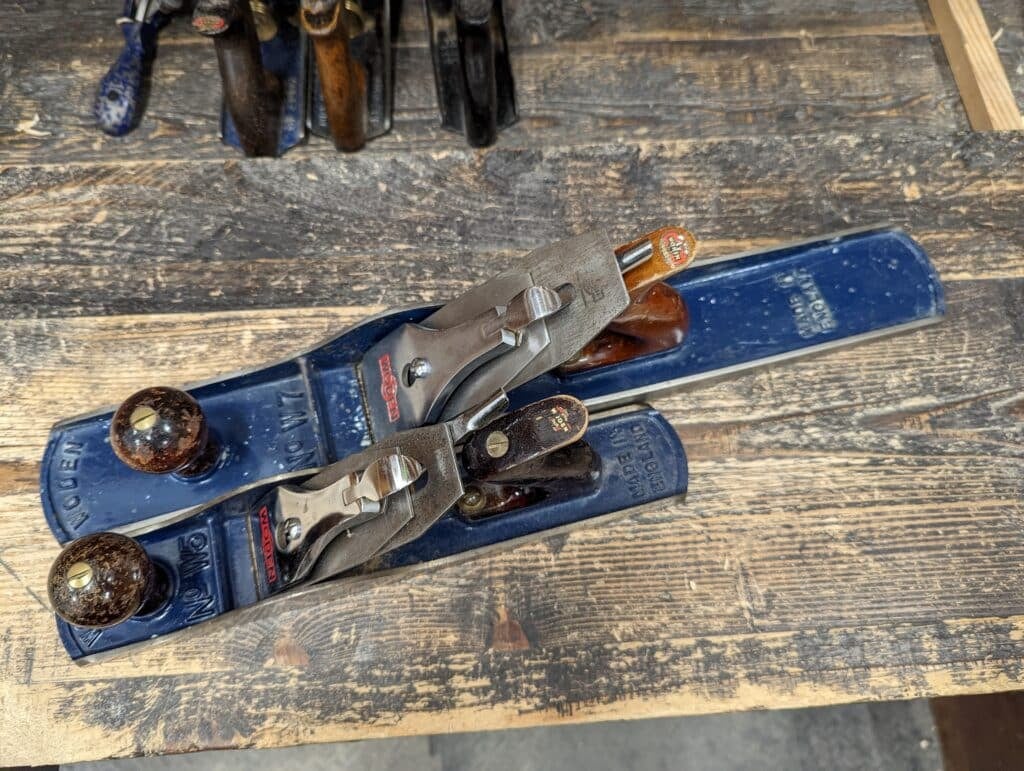
It’s most helpful to see that the plane setting on the bench planes is extremely important to our sanity and especially when we first start planing and using hand planes. I personally think you should at first keep the number of planes you buy to a minimum. You will find that in the bench plane group you will actually reach for the #4 and the #5 planes, use them for a while and get used to them, and then decide you do not need anything longer. So many fall into the trap of thinking they need every bench plane made in the series to get the wood just right. I mean what about the #8 Stanley or Record? The #7, the #6? Do you actually need any more length in a plane than a #5 or #5 1/2? Well, no, you don’t really. But of course, I am not selling tools and neither am I a collector. My long planes stay at the back of the others. Do I use them for ‘special‘ work, special projects? Well, I doubt that most of us can actually wield such lengthy planes and keep them true to the wood for truing. They are extremely awkward and heavy, so absolutely not. More than that, I actually think that they are a waste of space.
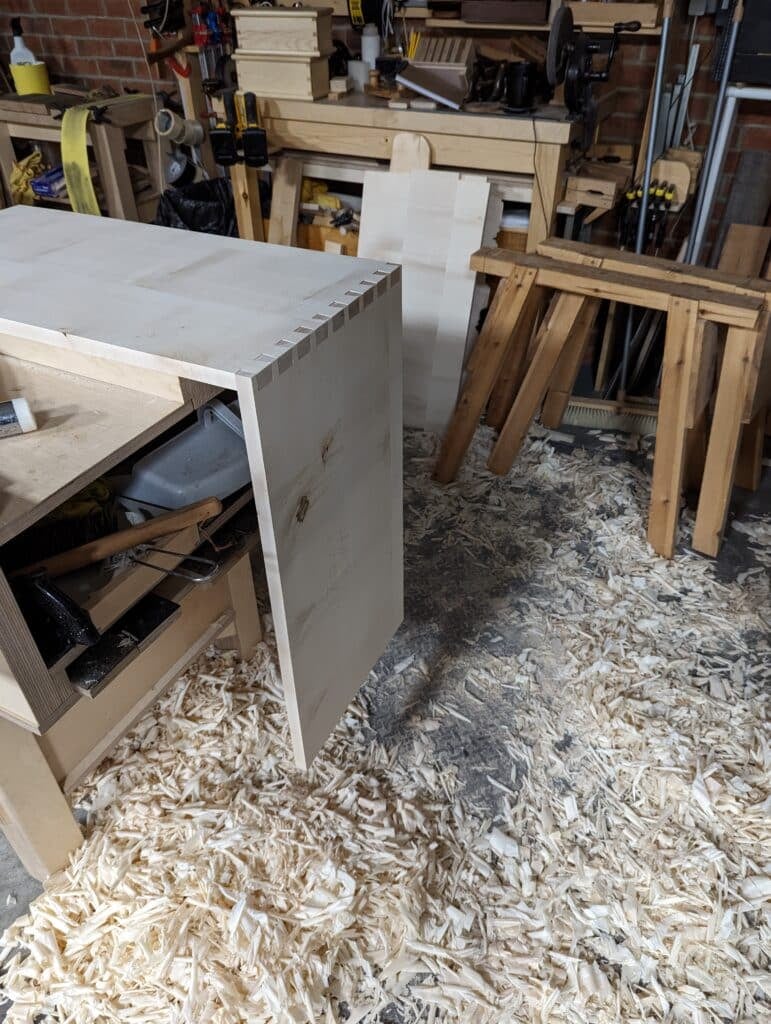
In some ways, it would be wonderful to dial in the depth of cut of a plane. A plane that self-levels and automatically aligns the cutting-edge parallel to the sole would be tremendous too. Were it possible, it would have been engineered by now, but Leonard Bailey did more than any plane maker/designer to get us close to the perfect plane and left us with a perfect level of involvement in the setting of the plane. We negotiate our settings according to what we feel in the pushing of the plane. Sometimes we can be too late and the strong stroke has failed us. I am glad we have to engage exactly as we do. There is just something about finding the sweet spot in any hand tool action that we can never achieve in any other way or by any other method of working wood.
I did some measuring recently. I measured the thicknesses of shavings to better know what thickness shavings are when the plane is set to match my skill and strength and to see what turns achieve what in terms of depth of cut per par-rotation. It’s one thing guessing this or that and another thing knowing a thickness even if it is only arbitrary. I found that a shaving of 0.14mm in oak was doable strength-wise according to that depth of cut when I wanted to take a heavy shaving but not one I would want to repeat for too long on a wide section of wood. Heavier shavings than that can be taken on narrow edges far more readily than on something a full plane width.
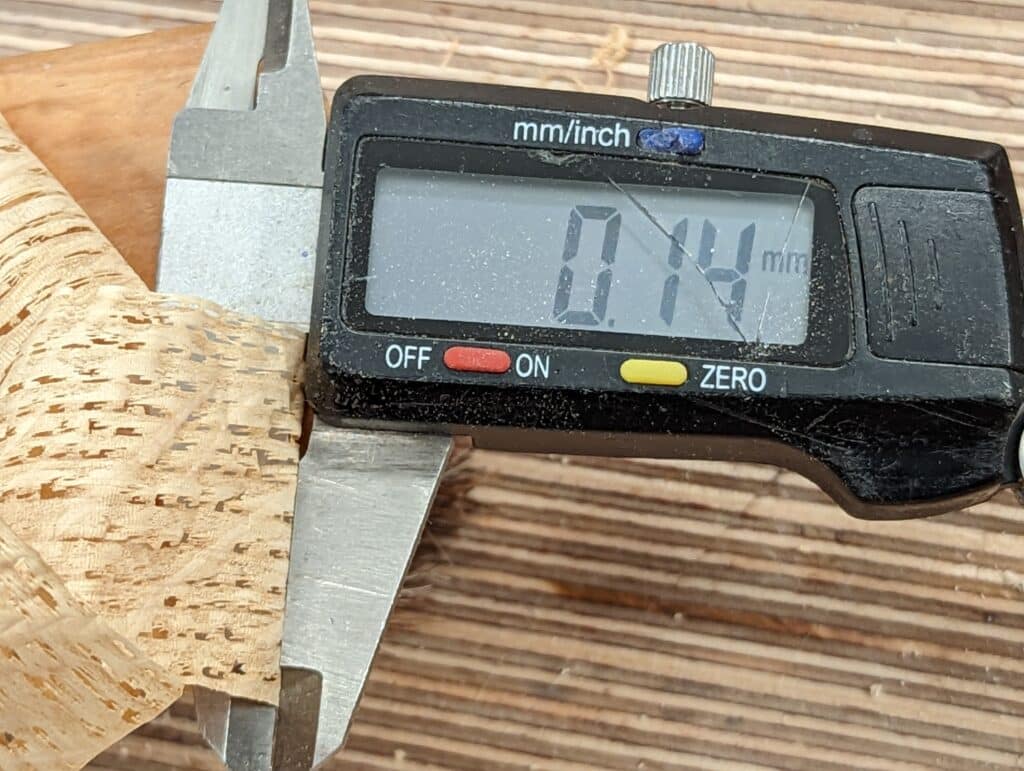
In planing this oak full width, I found that reducing the set to take thinner shavings produced a considerably better finish to the wood. I also felt that I ‘felt‘ the wood more sensitively and its refinement better through a less aggressive depth of cut; 0.07mm was an ideal thickness and on up to 0.12 came within the zone of comfortable but less so at the top end. Just how do you know how much of a rotation or partial rotation of the adjustment wheel will deliver at the cutting edge? You can simply measure it. A full rotation on any Bailey-pattern bench plane regardless of length or width will always be far too much if you have the set readied to already take off around 0.07. Rotating the wheel is a steady and ready delivery once the wheel has engaged the yoke and presses on the cutting iron assembly. You soon get used to gauging how much to rotate the wheel for a practical amount to take off. Generally, the best cuts are between 0.01mm, almost nothing, and 0.07. I am always conscious that the thicker shavings take so much more effort when you’d think a fraction more shouldn’t really make much difference. But I think it a good idea to see for yourself how much wheel rotation it takes to establish a different setting. You can do that by marking the adjustment wheel with a pencil line when the shaving is close to zero thickness. The vernier shows 0.01mm. For practical reasons I don’t need to get much closer to zero than this, an onion skin, so this is a good starting point:
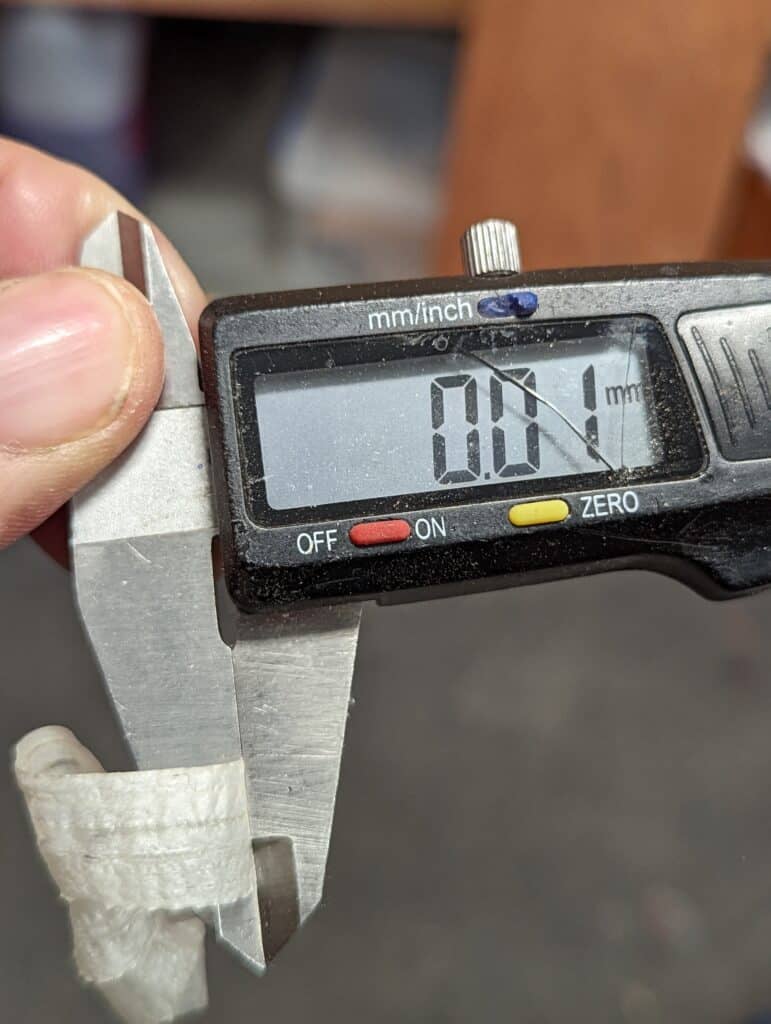
I take up any slack on my adjustment wheel to set this as the starting point and mark a line on the adjustment wheel. I can use this visual to register the start of the rotation so that when I rotate the wheel for a deeper cut and measure the thickness of the new shaving I can see exactly what the difference is.
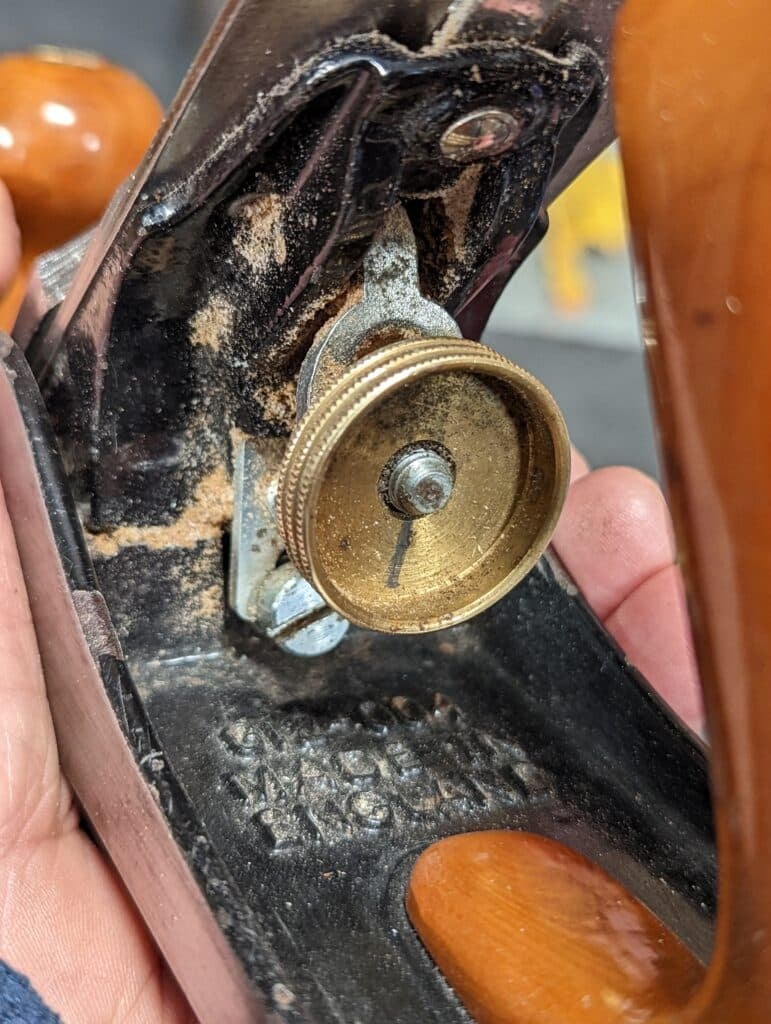
Turning it clockwise just one-eighth of a turn clockwise increased my depth of cut . . .
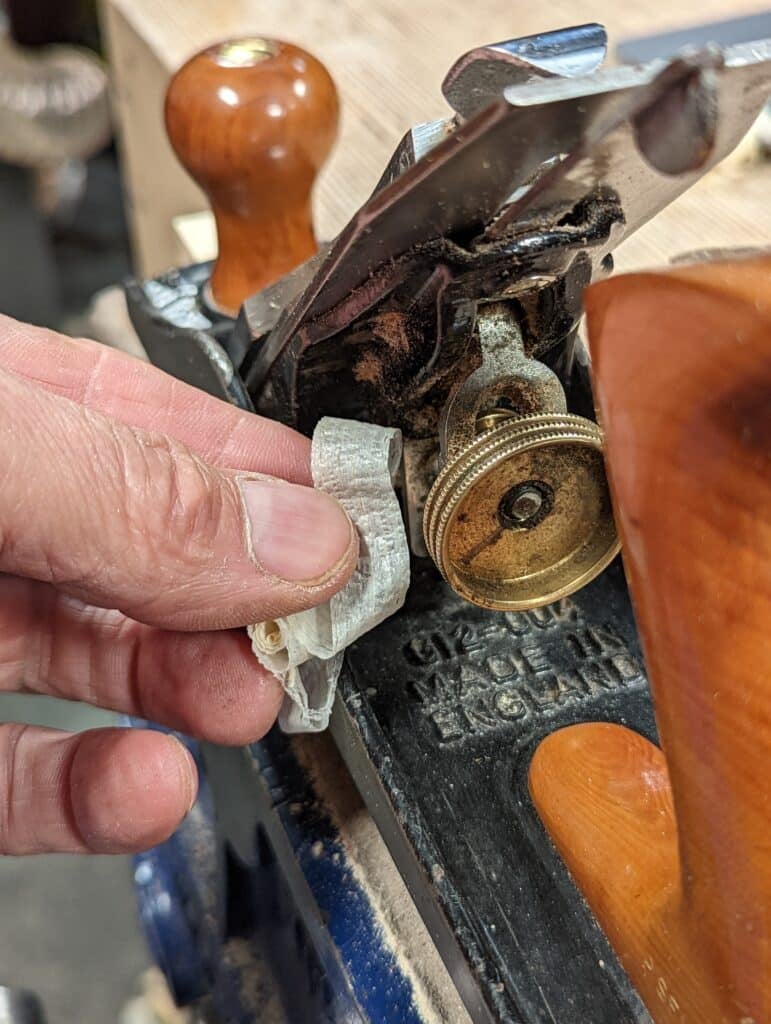
. . . and my new shaving measured an increase to 0.03–still paper thin.
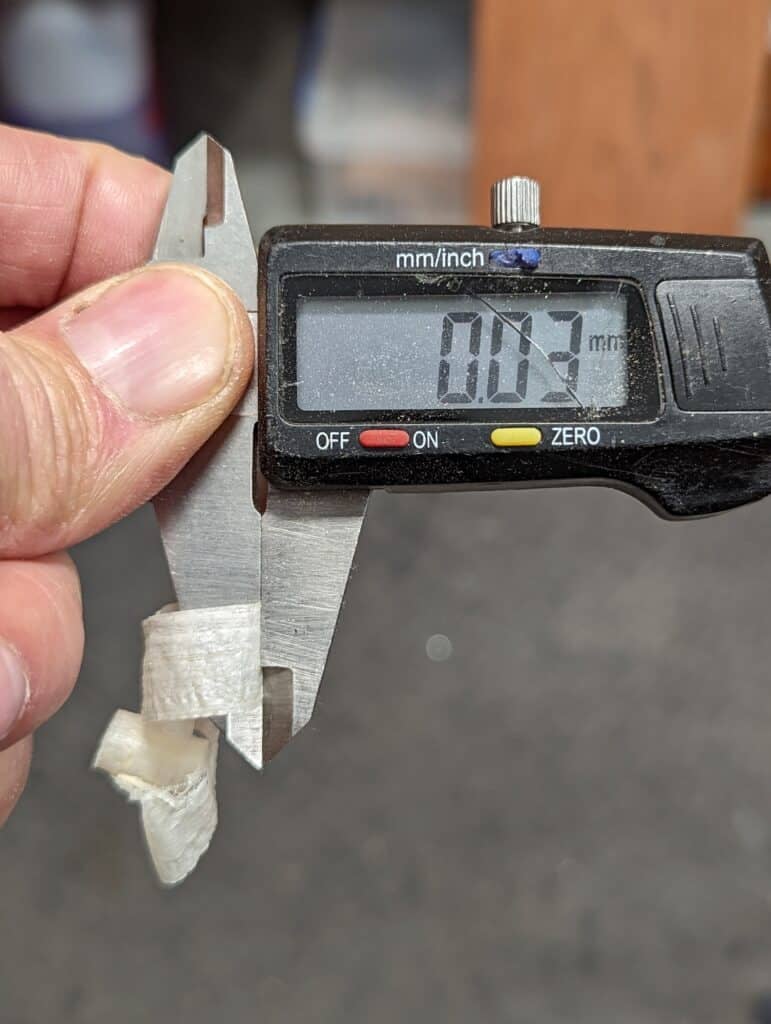
By the time I had rotated a full half turn the thickness had reached 0.13. Still easy enough to take a shaving but in this case, my material is only half an inch. On three-quarter to one-inch thick stock, planing the edge would be twice as hard and this must be considered minute-by-minute when changes are made to the setting.
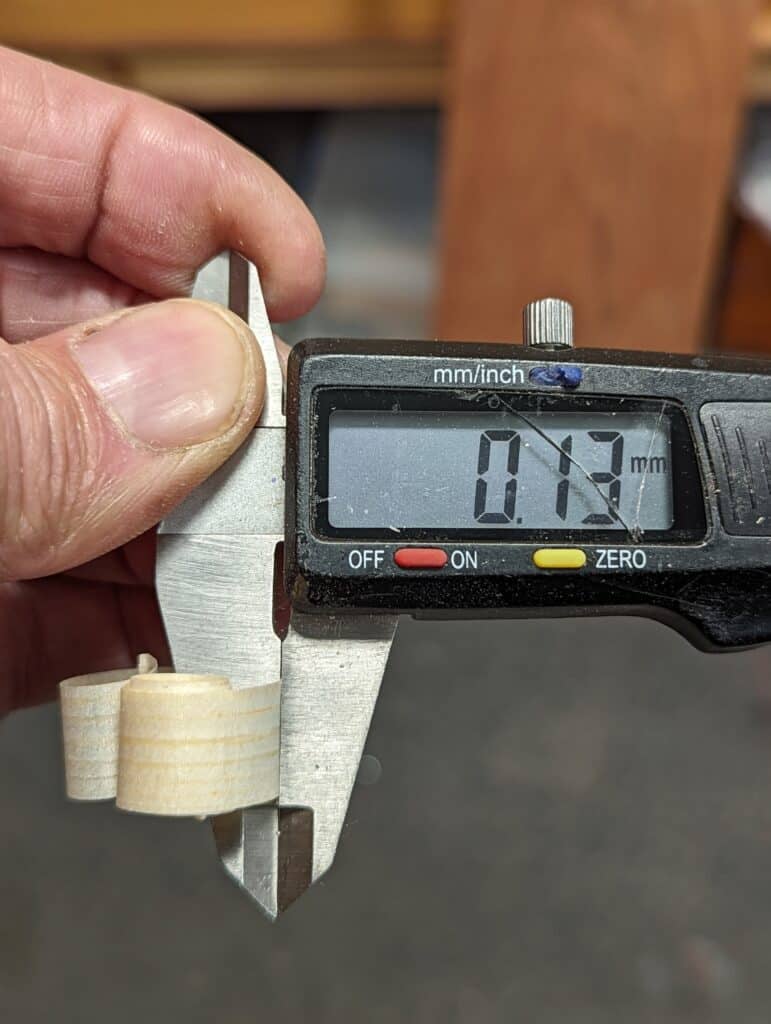
By now you will see that a full rotation almost always delivers a prohibitive cut and one of little value for surface planing but for removing the arris this full rotation might just be exactly right.
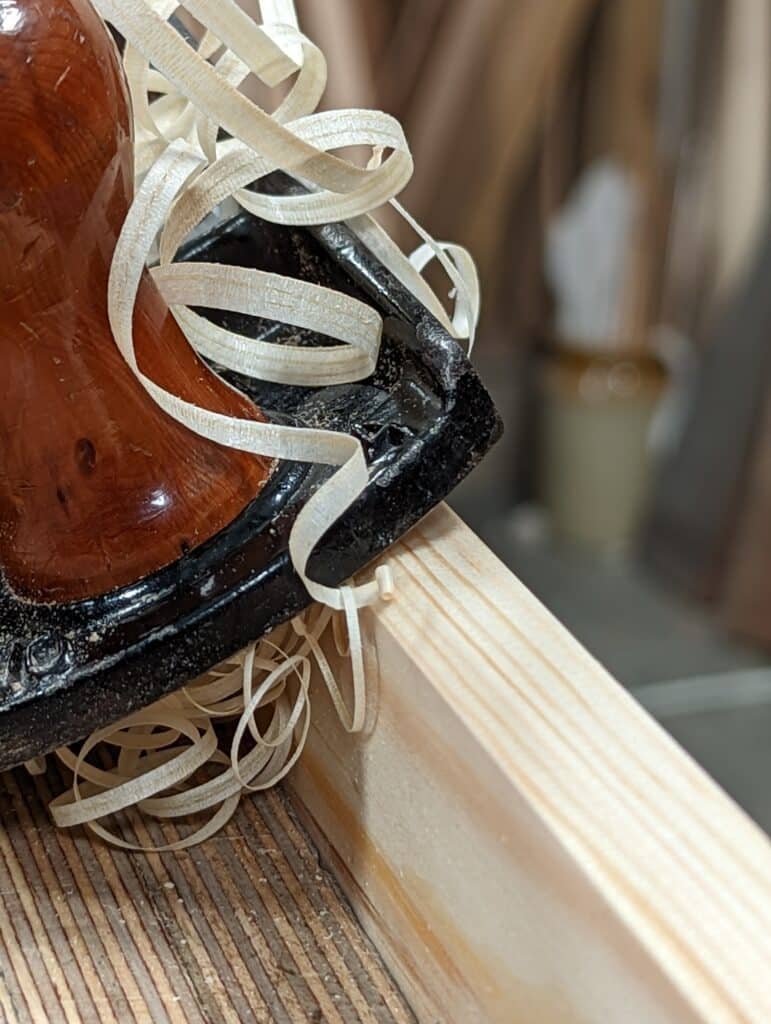
Every wood type you plane will give different impressions as no two woods will ever be just the same. Surprisingly, woods considered hard woods, woods like oak, ash and elm will plane more easily than softer woods and when you look at the shavings you can see why. Coarse-grained woods like this have much more openness to the fibres, those with more open pores throughout the grain plane much more easily. It becomes evident in the shaving when you lift it to the light.
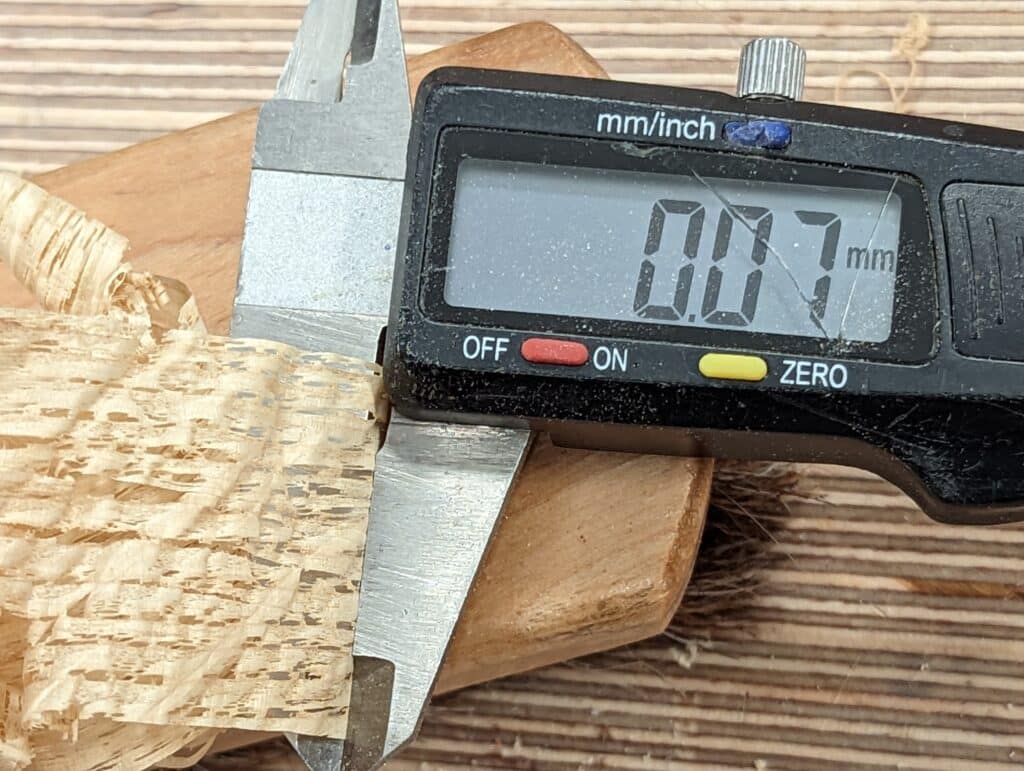
The gaps in the shaving above are the open pores characteristic of oak. The plane strokes easily work through grain like this as the pores may well represent 25% less actual wood. Other woods will be far more resistant to the plane, even many soft-grained woods.
Thickness may well not be consistent along the length of a continuous stoke. This varies slightly but we should be aware that pushing the plane effectively pulls the wood up at the point of cut and a shaving can be the minutest of a fraction thicker here and there. Here the thickness of the shaving showed 0.08mm.
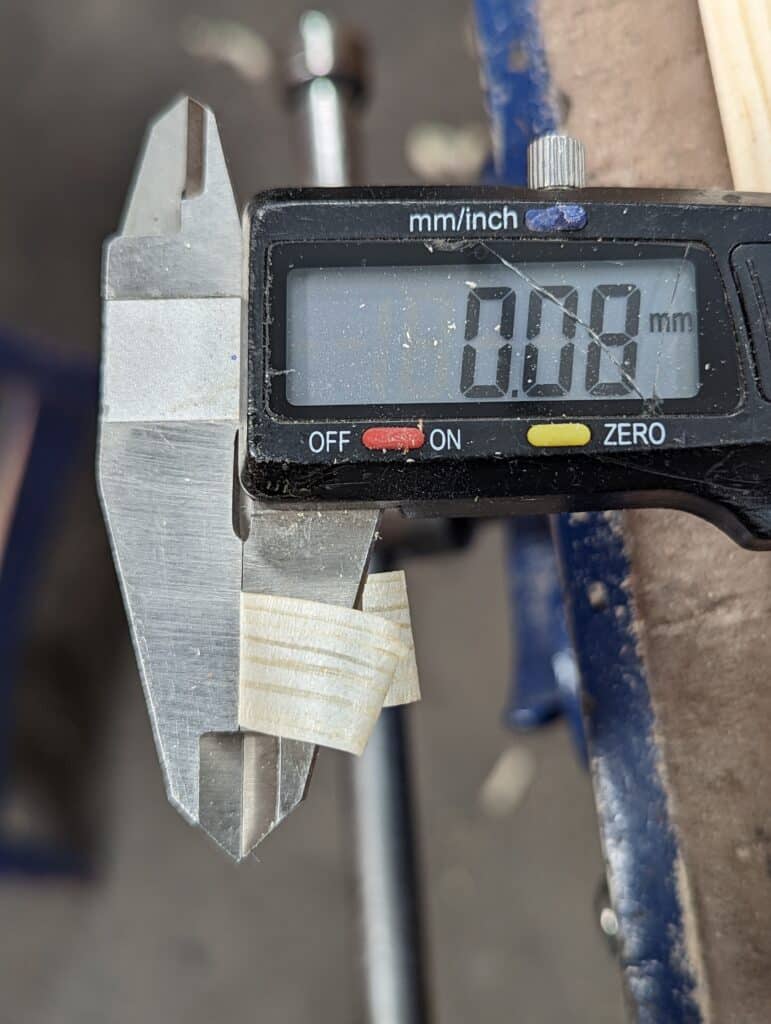
I stack up four shavings from the same stroke having cut the length into four sections and measured the overall thickness of what was an individual shaving 0.08 thick. The cumulative effect showed 0.36 so an average of 0.09.
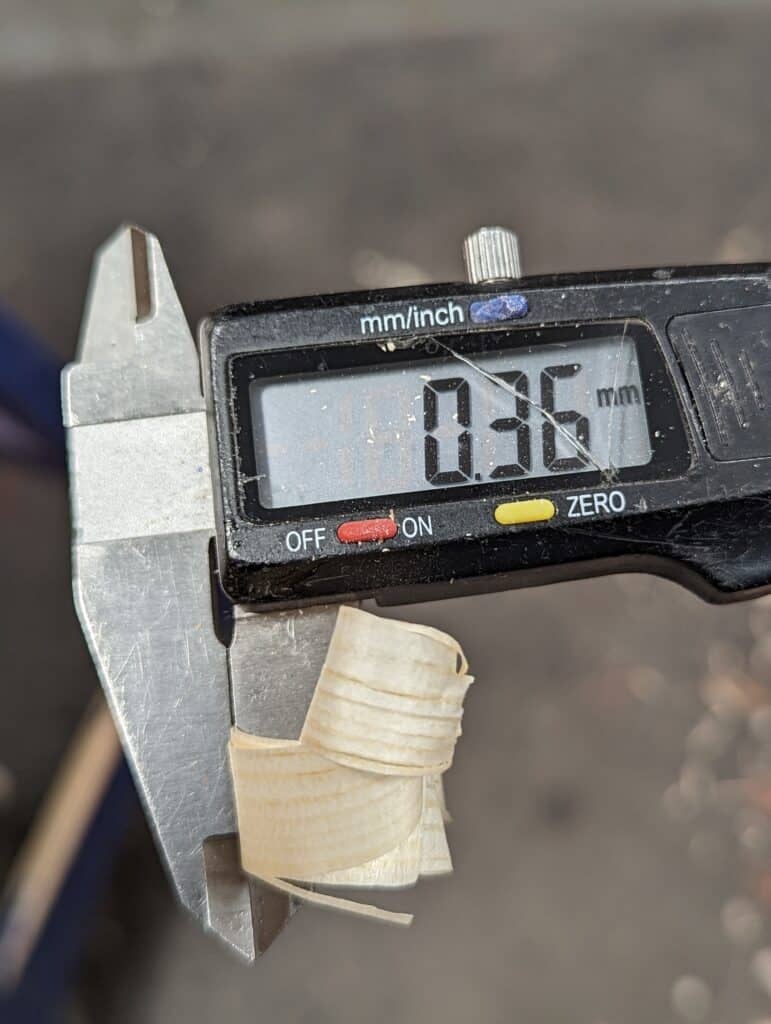
So, what am I saying? If you set your plane up correctly with the plane setting to a thin shaving, it’s quite informative to know just what your plane is doing at the cutting edge in terms of shaving thickness. the thread on your adjustment screw governs the depth of cut and then too the retraction of the cutting iron to take thinner shavings means consistent need for resetting the forward set for deeper cuts throughout a given day. Doing this just once will set the knowledge in your brain and you will know just what your favourite plane is doing.


I recently purchased a #6 (wanting a 5-1/2 for the wider iron, but used 6’s were cheaper than 5-1/2s). The first thing I discovered was if I was going to get anything substantial done with such a wide cut and a heavy plane, it would have to be with thinner shavings than I usually take with a 5. Perhaps I’ll do this test feeling for the same level of resistance from the 5 and the 6, and see what the difference of thickness is. I wouldn’t be surprised if it’s half.
Alex- after getting to the point where I could afford to start on my hand tools for wood journey, I was gifted a lovely #8 Bedrock from a roommate. Over time (and watching hundreds of videos from experts) I realized that the earlier names were definitely for a good reason. Fore planes are either the initial, or secondary to the heavily cambered scrub plane. Paul has an excellent video regarding plane choices for various needs. In essence he highly regards his #4 primarily for the versatility and ease of use. My rare heavy Bedrock has taken to the reserved area until I get my workbench built, and the final bit of finishing is required to fettle and sharpen. I also think that the mass and dimensions will make for a great shooting plane. Having acquired both regular and wide 4s, 5s, and the a 6, and the 8- mostly use the 4 and on occasion a 3 for smaller stock. The weight being so vastly different that makes the decision most of the time. Iffn I had the same amount of time peeling off wood as Mr. Sellers has there is a remote possibility that I could slap a piece of wood in the vise, run down it a couple of times and everything would be squared away and level. Maybe someday, butI still struggle with his abilities vs. mine. Hopefully this makes sense!
Great analysis on wood shaving thickness! Not totally related to shaving thickness, I do find having a lubricated plane sole makes a huge difference when planing. My cloth-in-can oiler is never far away when planing. I used to make several quick strokes with a bar of soap but find the oiler to be superior. Thanks for the video on making one of these oilers. I encourage all who would like to elevate their planing experience to lubricate the base of their plane to experience the difference with thin and thicker shavings.
+1
when I don’t forget to use the oiled cloth in the can, my plane feels twice as sharp.
great post, very timely for me. I have just been measuring my shavings. As a beginner in wood working I’ve often thought what is a ‘fine’ Vs a ‘thick’ shaving in terms of what is should expect to be able to achieve. Although I think the actual numbers do not matter that much I think they are helpful when learning remotely (on internet) because if in person we could touch/see/feel to get a better idea, via videos etc I think it does help to have that extra quantification. also I think the ‘thousandth of an inch’ phrase gets thrown about a little too freely sometimes.
I didn’t mark my adjuster (whish I had now) but instead just started thin, brought up by a slight turn and measured each time. I found it a worth while process if you have a caliper and also, a good idea to then go the other way to understand the backlash in the screw.
paul just came in from my shed
all made from skip wood
to find your lovely chat about wood shavings.
I live in an 1820 circa cottage…and determined to use my 1800 circa moulding planes.
currently mastering my thicknesser jig to make another chess board.
curly shavings on my raised pine table workbench….collected as fire lighters….wonderful
thank you paul
I would not trust a caliper to be that precise. While the digital ones give you a resolution of a hundredth of a millimetre my intuition is that the reason the Vernier scale on the analogue ones does not go beyond twentieths of the millimetre is because the instrument itself is not more precise than that.
It’s not a question of relying on anything but feel in the end. The vernier just gives an idea to anyone new to woodworking to understand thicknesses that’s all. Anyway, that wasn’t the point of the article. It’s funny how critics contribute so very, very little at the end of the day. Hmm.
I agree Paul as i use many situations of measuring as a guide more a accurate measurement, not that accurate doesn’t matter, in many certain situation it does matter, thank you for your teachings, so much appreciated. Dwayne
personally I find the measurements really helpful to calibrate new experiences
One has to read the text:
“Thickness may well not be consistent along the length of a continuous stoke. This varies slightly but we should be aware that pushing the plane effectively pulls the wood up at the point of cut and a shaving can be the minutest of a fraction thicker here and there.”
The caliper is used here to make comparisons, not to take precise measures. So as long as they are repeatable, the absolute value is unimportant.
“It is not the critic who counts; not the man who points out how the strong man stumbles, or where the doer of deeds could have done them better. The credit belongs to the man who is actually in the arena, whose face is marred by dust and sweat and blood; who strives valiantly; who errs, who comes short again and again, because there is no effort without error and shortcoming; but who does actually strive to do the deeds; who knows great enthusiasms, the great devotions; who spends himself in a worthy cause; who at the best knows in the end the triumph of high achievement, and who at the worst, if he fails, at least fails while daring greatly, so that his place shall never be with those cold and timid souls who neither know victory nor defeat.”
~ US President Theodore Roosevelt.
As someone in his day would’ve said approvingly, “Bully”.
Interesting post, as ever.
Many thanks.
not long ago I had a discussion on another wood working site with a person who purportedly was a woodworker. this Retrograde made the comment that a plane such as a Stanley 220 was totally useless and that planes can never replace sandpaper….I must agree somewhat with the latter statement, at least with me behind the plane.
then it struck me….This guy is a Framer and not even a carpenter. and his tool of choice is the pneumatic nailer and probably would hit his thumb trying to drive sinkers home with his hammer.
to each his own. I wished him good luck and closed out the conversation.
Another aspect beyond shaving thickness is shaving width. As I gain more experience, I find that shaving width is important for planing efficiency, but it requires advancing ones skills in sharpening and setting up the plane. By “setting up,” I mean getting the right interplay between depth of cut set with the knob and angle of the blade set by the lateral adjustment lever plus subtle aspects of sharpening. This affects whether passing the plane over the surface is like trying to color in a chalk board with the tip of a piece of chalk vs. covering it with the chalk on its side. Each fine tuning has its use. I did find that my level of skill, sensitivity, and experience had to go up a notch to get wide shavings that were’t too heavy and to understand when I wanted one vs. another type of shaving.
I bought a no 6 plane based on a blog you wrote around 5 years ago. I believe you mentioned that it’s the longest you would actually ever use. I find it a pleasure to use but it’s not nearly as useful as my no 5.
I use to obsess too much over flatness of stock . You can really use your eye to see if there is bow in a board like Paul always mentions.
Hand tools and kids are great! If you only work with power tools you really miss out on opportunities to teach the kids the craft (safely).
I have been wanting to try to make my own marking knife out of an old worn down plane blade from an estate sale. after reading your recent blog on blade hardening I gave it a try. I never tried cutting through a plane blade with a hack saw before so i was not sure how easy it should be, but it cut through very easily. I made two marking knives , one from each side of the blade. I shaped, put and edge on them, heated the ends to a glowing red and plunged into water. After doing this the steel was still very soft. I couldn’t easily snap the tip off, it just kept bending back and forth. Any thoughts on where I went wrong? thanks as always!
It would depend greatly on what kind of steel the blade is made from. A common one (or at least it used to be) is 0-1 tool steel. That would be heated to a cherry red and then quickly dropped into a container of oil (peanut oil doesn’t smoke and/or catch on fire like motor oil tends to), then its too hard and must be annealed by placing it in a 300/325º F oven for a half hour then allowed to cool naturally. Other steels have different requirements that may be out of the question for the home blacksmith. Use protective gear! Gloves, face shield, & etc.
Mr. Sellers,
The smile on the little girl depicted, coupled with the story of the one who hung on to her shaving as a keepsake for ten years (and counting) remind me of a memory I will carry to my grave. A little red headed, ten year old girl student who suddenly made the connection between the note printed on the sheet of music and the actual note she had just played on her guitar. The look on her eyes of understanding was priceless. Thanks for transporting me back well over 50 years and reminding me of her.
My father is a carpenter. I grew up on his job sites. From my earliest memories I think back with fondness as I walked and played picking up a bent nail here and there or a scrap of Douglas Fir that was cut into some really odd geometric shape with different angles on all sides. I remember walking under many trussed hip roofs after sheathing with broom in hand sweeping saw dust and being absolutely amazed at the wonder my dad had created with the rafters and trusses converging into each other at angles and pitches I couldn’t count. My father never used a hand plane but I’ll tell you, he was a master unsurpassed with that “diminished” claw hammer. He’d swing that thing all day long like an Anglo Saxon warrior swinging a sword in battle. He’d have a handful of nails sticking out of his mouth and another handful in his hand to replace them. He knew exactly how to drive those nails without splitting the ends of 2×4’s. Honestly there is nothing about the job my dad does that could even remotely be described as “diminished”. He could use a crosscut saw or a rip saw as deftly as you saw dovetails. When times changed and his crews switched to Skillsaws, he still cut just as precise as he did with a hand saw. He didn’t use a hand plane not because he couldn’t but because he didn’t need to. He’s the reason I love wood and hand tools. I don’t frame houses, I build furniture and fireplace mantels. But watching his skills as a child is why I am in awe of the craftsmanship of woodworking.
Well put Paul. (Up here I just seemed to call everyone Joiners. Uncle and father were Joiners, were attached to a funeral directors but made everything from doors, windows, furniture, caskets etc. A Chippy was that guy on Camberwick Green.)
Measuring shavings and the like are to me very useful benchmarking techniques. Knowing what my tools do on average at various settings has always been a help to me in selecting tools. Will a ‘normal’ scrub take off too much for cleanup, will a heavy 4 be just as quick or harder…..will I rip a particular board with a 4 too or 8 or…. Mostly it’s gut instinct/experience or even favourite but it’s very useful to have the benchmarks in your head.
like your dad, I would have been called a joiner. we made and fitted doors, frames and windows. On a new build if it was timber it’s was something we did, roofing, floors and all the second and final fix. on occasion we also looked after the departed making coffins and some of the lads acting as bearers at a funeral. I have never used any form of router or the like to cut out for hinges or locks and my hand plane saw hours of use. Most of the jigs and fixtures I have seen would have taken longer to set up rather than just getting on with the job using my hand tools
I’m new to your blog or whatever it is called; I was apprentice in a really old time firm we had one machine ;a huge bandsaw installed at the start of the first World war;our obsolete planer was worse than useless as we found it was quicker to true most tings by try plane & winding strips;the lack of machines meant very little dust and hardly any noise we could chat and so got to know each other very well. Our products were held in high regard and were worth of a high price;